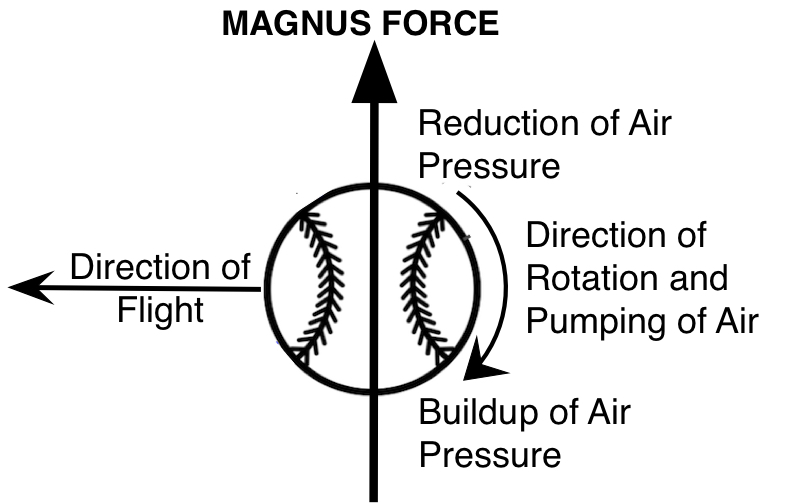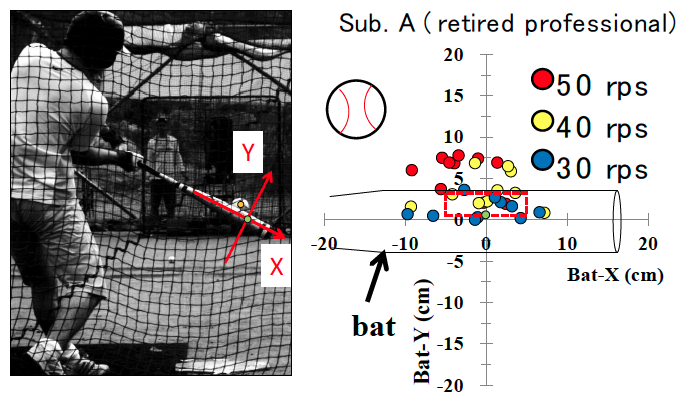Baseball is the subject of many artistic creations and scientific studies. Movies such as “Field of Dreams”, “Bull Durham”, and “Moneyball” depict baseball embedded in the larger American culture. Books such as the elegant “Game Time: A Baseball Companion”, by Roger Angell, are a literary pleasure even for someone only peripherally familiar with the game. And baseball has also engendered a broad culture of analysis through applied physics. The pitch is an object of particular fascination for the physics-inclined baseball fan. And the fastball features large in that fascination.
At the heart of every analysis of the pitch in baseball are ball speed and “movement”, whether it goes straight over the plate or moves down, left, or right, or some combination of those movements. The basic bread-and-butter pitch is the fastball, which challenges the batter with speed. There are some contentious issues concerning the fastball.
Forces affecting fastball speed and movement
Every pitch, whether a fastball, Curveball, slider or something else, experiences the forces of drag and gravity. Drag is obvious: as the pitch makes its way through the air it is slowed down. The speed of a ball that leaves the pitcher’s hand at 100 mile per hour (mph; baseball numbers are usually discussed in ‘American units’) drops to about 85 mph by the time it hits the catcher’s glove. A radar gun, similar to the device that catches speeders on the highway, was first used to measure the speed of the ball in a ballgame on September 7 , 1974. The pitcher was Nolan Ryan of the California Angels. A radar gun specially calibrated by Rockwell-American International was trained on a point about 10 feet in front of home plate. In the ninth inning, looking at a count of 3-1, Ryan threw his fastest pitch of the day, a strike, at 100.9 mph.
Since then, electronic tracking of the ball during the game, and instant replays of its path through all phases of pitching, hitting, and fielding has become standard. Cameras and radar tracking devices are used, although controversy sometimes still arises about their accuracy. What isn’t much argued is that the hottest fastball today comes from the arm of “The Cuban Missile”, Aroldis Chapman. In 2010, Chapman recorded the highest number yet on the radar gun, with a speed of 105.1 mph. So, faster than Ryan.
Maybe not. As explained in the delightful documentary “Fastball” (currently available on Netflix), the Carnegie Mellon physicist Gregg Franklin explains why Ryan was probably faster. When Chapman was clocked, speed was being measured 50 feet in front of home plate, just after release, when the pitch is travelling its fastest. But Ryan’s measurement, in 1974, was made 10 feet in front of home plate. In the intervening 40 feet, it is estimated that his pitch slowed by about 8 mph due to drag. If so, Ryan had the hottest fireball, at about 109 mph at release. So why not just measure Chapman at 10 feet in front of the plate, to make a direct comparison? Probably because major league baseball likes its numbers to be as large as possible, and reporting that a pitch was actually 98 mph, not 105.1, doesn’t sound as impressive.
As for Ryan, not only was he probably the fastest pitcher so far, he was also one of the most durable: he typically threw 150 to 175 pitches a game, about 40% more than a sensible manager today allows his starting pitcher to throw. He has the all-time strikeout record of 5,714, far higher than the next highest. His seven no-hitters is three more than the next best. But one day in September, 1993, he suddenly felt his elbow give out, and he walked off the mound having posted his last strikeout. He was 46. As for his fastball, his catcher at the time said that he didn’t think that the pitch timed on September 7, 1974 was his fastest; it was waist high, and he thought Ryan’s pitches higher in the strike zone were generally faster.
Gravity, and the Magnus effect
The earth attracts everything, including the pitched baseball. But how much, and, can’t a fastball thrown hard enough go straight, oblivious to gravity? The answer to the second question is no, although it’s a slightly complicated “no”. A fastball travelling at 100 mph at release takes about 0.40 seconds to reach the batter (who is usually crouched near the back of the batter’s box). Physics says that if no other force is involved, the ball will “fall” about 31 inches from the point the pitcher aimed it. That’s calculated from the law of gravity, which says that objects fall 1/2•g•t^2 in t seconds (where g is the gravitational constant, 32 feet per second per second). In this case of the fastball, that comes to 16x(0.40)x(0.40) feet, or 31 inches. And gravity applies at the ball park just as everywhere else. So as it approaches the batter, the fastball is sinking.
But there’s another force acting on the pitch, and working against gravitational pull, due to something called the Magnus effect (1). The Magnus effect is a critically important aspect of the baseball pitch. It is responsible for the break of the Curveball and the slider, and it is an important part of the flight of the fastball, countering the force of gravity. Figure 1 illustrates the Magnus force as it applies to the 4-seam fastball.

To throw a 4-seam fastball, the pitcher grips and throws the ball so that four seams rotate through the line of flight; it has backspin. That is, the pitcher whips his fingers down during release to give the ball a spin that looks clockwise viewed from the first base line, as in the figure. A rotating baseball, like any object flying through space, will have a thin layer of air associated with its surface. The association of this layer with the ball is enhanced by its seams, which protrude slightly outside the perfect round of the body of the ball. Relative to the surrounding air, this layer of air will be moving faster than the speed of the baseball on the upper surface because it is moving away from the direction of the pitch. On the lower surface, it will be moving slower. This acts as an “air pump”, and pushes more air under the ball than above it. This produces a higher pressure underneath than above, and the ball experiences an upward force. This is the Magnus force.
Tennis players and footballers are well aware of the effects of the Magnus force. It’s what allows a kicker to bend it like Beckham. In baseball, a sideways spin is responsible for the slider, and topspin for the dramatic dip of the “12-6 Curveball”. As anyone who plays any ball sport knows without involving any physics, if you spin the ball you get a curved flight. In the case of the fastball, where the spin is vertical, it acts against gravity, so instead of the ball “falling” 31 inches on its way to home plate and the waiting batter, it will fall a few inches less. And that leads directly to…
The batter’s dilemma
A batter in baseball, no matter how gifted, faces a physiological limit. Namely, his brain cannot process visual input fast enough to accurately track a fastball all the way to the strike zone. It takes about 100 milliseconds (1/10 second) for the brain to process visual input, and a similar time to make a decision and swing the bat. That means, the visual input on which a swing is based stops when a fastball is about half way to home plate. What the batter swings through is the place his brain projects the ball will be when it reaches him. But if the ball is not following the path expected by the brain, the swing may miss, and most of the time, it does. Any pitch can fool the batter; Curveball, slider, or fastball. A fastball can be deceptive when it doesn’t fall as far as the batter’s brain expects it to. In other words, if there is enough of a Magnus force to put the ball above where it “should” be.
This effect is demonstrated in a series of recordings of pitches delivered by a pitching machine with various spin speeds. Figure 2 illustrates where the experienced batter would expect the ball to be, which corresponds roughly with the behaviour of a 90 mph fastball spinning at 30 rotations per second (1,800 rpm). Higher backspins, 40, or 50 rotations per second (2,400, or 3,000 rpm), caused the human batter to underhit most of the time.

The deviation of the backspinning fastball from a pitch thrown at 90 mph with no spin is significant. At this speed, the ball “falls” about 38 inches from the pitcher’s aiming point. The fastball spinning at 1,800 rpm crosses the plate 70 cm (28 inches) higher than one with no spin (Kanosue et al.). The human batter in the figure has estimated the flight path based on experience. His guess would give him contact with a ball spinning at 1,800 rpm. But there’s a narrow window of success. The experienced batter swings the bat 28 inches above where the non-spinning ball would fly, but Nolan Ryan’s fastball rotating at 2,100 rpm crosses the plate a couple of inches higher. Swing at thirty inches, contact; 28, a swing and a miss, or a foul tip.
The myth of the rising fastball
Since the force of the Magnus effect on a backspinning fastball is upward, is it possible that the ball could actually rise during its flight? In the documentary “Fastball”, a number of retired veteran ballplayers are sitting around, discussing what it was like to stand in against fastballers like Nolan Ryan, Sandy Koufax, or Bob Gibson. And almost to a man, they insist that some of those pitches actually rose as they approached the plate. Is it possible to throw a rising fastball?
In fact, it is possible for a ball to rise in flight. A well-struck golf ball, with a high rate of backspin, has an upward curvature as it rises in flight before it descends. One of the most charming analyses of ball flight, focusing on the golf ball, was published by J. J. Thomson in 1910 (online here). Thomson discovered the electron, for which he won a Nobel Prize in Physics in 1906. As in baseball, it is the backspin of the golf ball that imparts lift, and Thomson analyzed in detail the Magnus force producing it. (He also talks about the effects of side-spin, which produce deviations to left or right, which bedevil all of us from time to time.)
A golf ball can experience “lift” that temporarily overcomes the force of gravity because it is relatively light, is hit at great speed, and, for a well-struck iron shot, may be backspinning at a rate of as much as 10,000 rpm. A baseball, on the other hand, cannot. Despite what the old timers claim, no pitcher can throw the ball fast enough and with enough spin to cause it to rise due to the Magnus force. Physicists calculate that to rise (link here), a pitcher would have to deliver a ball that crosses the plate at 170 mph if the spin rate were the highest ever recorded, 2,300 rpm. Or, if he could “only” muster 100 mph, he would have to put 3, 600 rpm of backspin on the ball. The camera evidence supports the physicists. On the other hand, the physicists haven’t had to stand in and tremble in fear as Bob Gibson delivers his heater, which could be coming at your head.
The more likely explanation for the perception of the rising fastball is tendered by physicists and physiologists (2). If the batter is subconsciously thinking 90 mph fastball and making a decision where and when to swing based on that, a ball thrown at 95 mph will be a couple of inches higher at the plate, just enough to cause him to swing under it. Like the batter in Figure 2. There isn’t time to adjust. During the first 200 milliseconds or so, the 90 and 95 mph fastball travel almost the same trajectory, and the batter’s brain is making a projection of where the ball will cross the plate (explained further here). But during the last 200 milliseconds, when the batter’s vision and bat-swinging facilities can no longer adjust, the trajectories of the 90- and 95-mph fastball are different. Hence the perception of the “rising fastball”.
The special case of the Knuckleball
One warm and fragrant night last summer I attended a baseball game. It was between teams made up almost entirely of US college students, playing in a summer league with teams in a number of smaller cities in the Pacific Northwest. In the 8th inning, the manager of the local team brought in a pitcher who was particularly well received by the fans. To my surprise, that reliever was a young local woman, the only female on either team. As she briefly warmed up before the first batter stepped in, I was a little concerned because her pitch speeds were registering only around 60 mph. They’ll murder her, I thought. Then I noticed that the catcher was often having a hard time catching it cleanly, and I suddenly realized that she was throwing knuckleballs. The dreaded knuckler. Also known as the fingernail ball, the flutterball, the floater, and the ghostball, among other names, often with an expletive inserted.
The Knuckleball has a history almost as long as the sport of baseball’s, but it doesn’t have many practitioners. It has been estimated that, overall, only about 70 Knuckleball pitchers have played in the major leagues. One of its names is “the spinner”, which is odd, because it hardly spins at all. Properly thrown, it may rotate 1 or 2 times on its trip to the plate, while the fastball may spin 16 times. The pitcher grips the ball in a peculiar way, usually with the tips of 2 or 3 fingers, often using the fingernails, and throws it with a slightly awkward, and not very athletic, motion. (The term Knuckleball refers to its early history, when the pitchers would grip the ball with their knuckles.) It’s not as hard on the pitcher’s arm as other pitches, and its practitioners, provided they keep their skill intact, can play until almost 50 years old.
The Knuckleball is viewed askance by some baseball purists, and you might wonder why any pitchers even bother with it. They bother because, well executed, it’s almost unhittable. It has the virtue of an unpredictable flight path. The barely-spinning knuckler is affected by the airflow over its surface in an asymmetric way, with the seams causing greater drag on one side or another, causing it to veer, and even to change direction as it lazily rotates. Veterans marvel at some sense-defying Knuckleball pitches that rotate around the axis of the flight path. If hitting a fastball depends on making the right estimation of trajectory when the pitch is still 25 feet out, hitting a corkscrewing Knuckleball depends pretty much entirely on luck.
The pitcher has little control on the precise behaviour of the ball, and catchers hate it. It’s so difficult to catch that often a team that has a knuckleballer on its roster will have a catcher designated to catch him. And chances are, he will use a larger glove, such as a softball catcher’s. Batters aren’t the only ones left guessing. Joe Torre, one-time manager of the New York Yankees and himself a former catcher, once said, “You don’t catch the Knuckleball. You defend against it.”
Very few pitchers today take the time to master the Knuckleball, but those that do pose a real threat to batters, at least on a good day. On a bad day, or for one bad pitch, the Knuckleball can be home run fodder. A Knuckleball pitcher who is extremely effective in getting outs one day can suddenly lose his ability to throw strikes, and his confidence, the next time out.
A cannonball is like a Knuckleball
Before rifled artillery and guns became ubiquitous, in the age of smoothbore rifles and cannons, projectiles had to be round. Otherwise they would tumble and become completely unpredictable in flight. But cannonballs and musketballs often have small imperfections in shape, as do smoothbore barrels, and the powder charges can ignite less than perfectly symmetrically. As a result, round projectiles often experienced random rotation as they flew. Like a Knuckleball, somewhat unpredictable in trajectory. You wonder what would happen to a spherical projectile with a controlled backspin.
Rifled guns fire rotating, elongated projectiles which are stabilized by spin around their long axis. There’s a whole additional science bearing on the stability of such flight.
Update
On July 20, 2021, the New York Times carried a story about the change in on-base percentages (increased) and strikeouts (decreased) that took place after the league announced it was going to crack down on the use of illegal “sticky substances” by pitchers. The spin rates dropped by 4% as a result, and the number of no-hitters stalled. The use of a sticky substance puts more spin on the fastball, decreasing the rate it falls during the delivery, and increasing its apparent “rise”.
Go To Contents
Sources
General information: “Project Knuckleball”, by Ben McGrath, The New Yorker, May 17, 2004.
- Nathan, A. M. 2008. The Effect of Spin on the Flight of a Baseball. American J. Physiology 76:119-124.
- Bahill, A. T., and W. J. Karnavas. 1993. The Perceptual Illusion of Baseball’s Rising Fastball and Breaking Curveball. J. Experimental Psychology 19:3-14.
- Higuchi, T., J. Morohoshi, T. Nagami, H. Nakata, and K. Kanosue. 2013. The effect of fastball backspin rate on baseball hitting accuracy. Journal of applied biomechanics 29:279-284.




